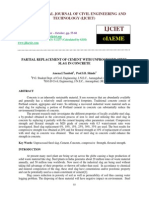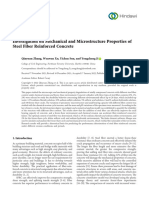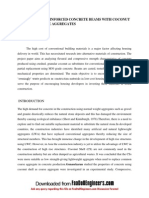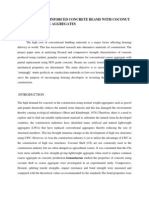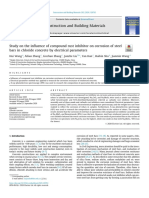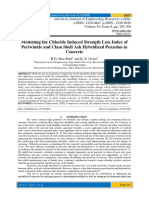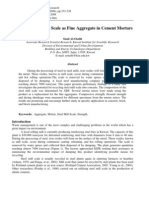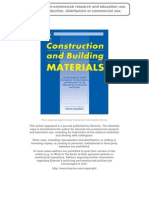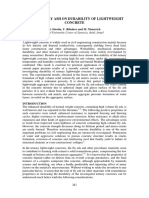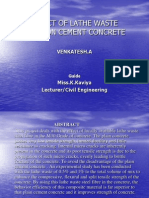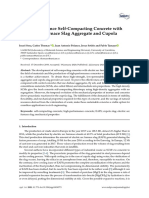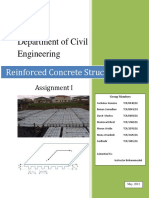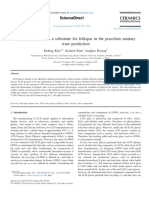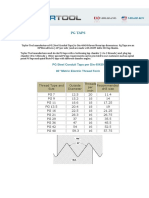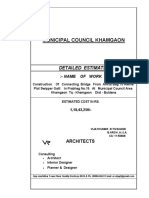0 ratings0% found this document useful (0 votes)
36 viewsExperimental Study On Concrete Using Steel Slag As Partial of Fine Aggregate
Experimental Study On Concrete Using Steel Slag As Partial of Fine Aggregate
Uploaded by
shara000This document summarizes an experimental study on using steel slag as a partial replacement for fine aggregate in concrete. The study tested concrete mixtures with 0%, 25%, 50%, and 75% replacements of fine aggregate with steel slag. Compressive strength and split tensile strength were tested at 7, 14, and 28 days. Results showed compressive strength and split tensile strength generally decreased as the steel slag replacement ratio increased. However, mixtures with 25% steel slag replacement performed similarly to normal concrete. The study concluded that using steel slag up to 25% replacement is feasible and can provide a sustainable use for this industrial byproduct while not significantly affecting concrete strength properties.
Copyright:
© All Rights Reserved
Available Formats
Download as PPTX, PDF, TXT or read online from Scribd
Experimental Study On Concrete Using Steel Slag As Partial of Fine Aggregate
Experimental Study On Concrete Using Steel Slag As Partial of Fine Aggregate
Uploaded by
shara0000 ratings0% found this document useful (0 votes)
36 views28 pagesThis document summarizes an experimental study on using steel slag as a partial replacement for fine aggregate in concrete. The study tested concrete mixtures with 0%, 25%, 50%, and 75% replacements of fine aggregate with steel slag. Compressive strength and split tensile strength were tested at 7, 14, and 28 days. Results showed compressive strength and split tensile strength generally decreased as the steel slag replacement ratio increased. However, mixtures with 25% steel slag replacement performed similarly to normal concrete. The study concluded that using steel slag up to 25% replacement is feasible and can provide a sustainable use for this industrial byproduct while not significantly affecting concrete strength properties.
Original Description:
project
Original Title
11th Batch
Copyright
© © All Rights Reserved
Available Formats
PPTX, PDF, TXT or read online from Scribd
Share this document
Did you find this document useful?
Is this content inappropriate?
This document summarizes an experimental study on using steel slag as a partial replacement for fine aggregate in concrete. The study tested concrete mixtures with 0%, 25%, 50%, and 75% replacements of fine aggregate with steel slag. Compressive strength and split tensile strength were tested at 7, 14, and 28 days. Results showed compressive strength and split tensile strength generally decreased as the steel slag replacement ratio increased. However, mixtures with 25% steel slag replacement performed similarly to normal concrete. The study concluded that using steel slag up to 25% replacement is feasible and can provide a sustainable use for this industrial byproduct while not significantly affecting concrete strength properties.
Copyright:
© All Rights Reserved
Available Formats
Download as PPTX, PDF, TXT or read online from Scribd
Download as pptx, pdf, or txt
0 ratings0% found this document useful (0 votes)
36 views28 pagesExperimental Study On Concrete Using Steel Slag As Partial of Fine Aggregate
Experimental Study On Concrete Using Steel Slag As Partial of Fine Aggregate
Uploaded by
shara000This document summarizes an experimental study on using steel slag as a partial replacement for fine aggregate in concrete. The study tested concrete mixtures with 0%, 25%, 50%, and 75% replacements of fine aggregate with steel slag. Compressive strength and split tensile strength were tested at 7, 14, and 28 days. Results showed compressive strength and split tensile strength generally decreased as the steel slag replacement ratio increased. However, mixtures with 25% steel slag replacement performed similarly to normal concrete. The study concluded that using steel slag up to 25% replacement is feasible and can provide a sustainable use for this industrial byproduct while not significantly affecting concrete strength properties.
Copyright:
© All Rights Reserved
Available Formats
Download as PPTX, PDF, TXT or read online from Scribd
Download as pptx, pdf, or txt
You are on page 1of 28
Experimental Study on Concrete
using Steel slag as Partial
Replacement of Fine Aggregate
Guided by Project Member
Mr. M.Dhinakar B.E,(M.Tech) M.Ganeshmoorthi
Pro-Term Lect/CIVIL S.Sakthivel
N.Jagadesh
Concrete is the third largest material consumed by
human beings after food and water.
Environment of this only living planet is wary of
pollution due to emissions of a host of green
house gases from industrial processes.
Due to demand for reducing overexploitation of
the natural quarries, the use of the by-products
from different industries has become an
increasing practice in the sustainable construction
industry.
ABSTRACT
Steel slag concrete mixes have very high
stabilities and satisfactory flows and
excellent stripping resistance.
Steel slag used as surface course has good
wear and skid resistance.
Steel slag mixes have good heat retention
and compatibility.
When in contact with moisture, steel slag has
a potentially expansive nature up to 10%
attributed to the hydration of the free Cao
and magnesium hydrates.
STEEL SLAG
GENERAL SCHEMATIC VIEW OF BLAST
FURNACE OPERATION AND SLAG
PRODUCTION
LITERATURES REVIEW
USE OF FURNACE SLAG AND WELDING SLAG
AS REPLACEMENT FOR SAND IN CONCRETE
Sreekrishnaperumal Thanga Ramesh*
In this project, a study was made to obtain low cost building
materials using industrial wastes (welding and furnace slags).
Different fine aggregate replacements have been studied by
substituting 5%, 10%, and 15% of slag.
Experimental studies were conducted only on plain cement concrete.
The preliminary studies were conducted by mixing the slag with the
cement concrete cubes of standard sizes.
The optimum compressive strength of concretes after 28 days has
been found to be 41 N/mm2 for 5% welding slag and 39.7 N/mm2
for 10% furnace slag replacements.
2.CONCRETE CONTAINING STEEL SLAG
AGGREGATE: PERFORMANCE AFTER HIGH
TEMPERATURE EXPOSURE
Netinger : Faculty of Civil Engineering, Josip Juraj Strossmayer University of Osijek,
Osijek, Croatia.
Due to demand for reducing overexploitation of the natural quarries,
the use of the by-products from different industries has become an
increasing practice in the sustainable construction industry.
Steelmaking slags are composed principally of calcium silicates,
calcium aluminof- errites, and fused calcium oxides, iron,
magnesium, and manganese.
Organic, semi-volatile and volatile compounds are not present in the
steel slag due to the fact that they are made at high temperatures
dur- ing production process.
Steel slag is generated as a melt at about 1600C during steelmaking
from hot metal in the amount of 15%20% per equivalent unit of
steel.
The function of this slag is to refine the steel of sulphur and to
absorb the oxides formed as a result of deoxidation during steel
production.
3.STUDY ON THE PARTIAL REPLACEMENT OF FINE
AGGREGATE USING INDUCTION FURNACE SLAG
Ansu John and Elson John
Department of Civil Engineering, Mar Athanasius College of Engineering, Kothamangalam,
India.
In this study the compressive strength characteristics of mortar and
concrete made with partial replacement of fine aggregate using
induction furnace slag was considered.
The aggregates occupy almost 70-75 percent of the total volume of
concrete.
The civil engineering construction particularly in the field of
reinforced concrete has increased and as a consequence the
availability of aggregate has reduced by a large amount, which has
led to hike in its cost.
To meet the global demand of concrete in the future, it is becoming
a challenging task to find suitable alternative construction materials
which can fully or partially replace the natural aggregate without
affecting the property of concrete.
METHODOLOGY
Material Collection
Study of property
Mix Design(M30)
Casting of Specimen with
various mix proportion
25%, 50%, 75%
Mechanical properties of
various mix
Comparison of
result
TEST ON MATERIALS
1.Test on cement
Specific gravity of cement =3.15
2.Test on coarse aggregate
Specific gravity of coarse aggregate =2.70
Water absorption of coarse aggregate =2.6%
3.Test on fine aggregate
Specific gravity of fine aggregate =2.68
Water absorption of fine aggregate =2.5%
4.Test on steel slag
Specific gravity =3.2-3.6
Water absorption =up to 3%
MIX PROPORTIONS FOR ONE CUM OF
CONCRETE
1.Mass of Cement : 415 kg/m
3
2.Mass of Water : 186 lit/m
3
3.Mass of Fine Aggregate : 750 kg/m
3
4.Mass of Coarse Aggregate : 1125 kg/m
3
5.Water Cement Ratio : 0.45
CEMENT F.A C.A WATER
CEMENT
RATIO
1 1.80 2.7 0.45
CALCULATION
Comparison of Compressive strength
% of Steel slag
Average
Compressive
Strength
(N/mm
2
) at
7 days
Average
Compressive
Strength
(N/mm
2
) at
14 days
Average
Compressive
Strength
(N/mm
2
) at
28 days
0% 10.43 20.36 31.25
25% 9.77 19.70 30.22
50% 7.70 15.40 24.73
75% 4.59 10.95 19.84
COMPRESSIVE STRENGTH AT 7 DAYS
10.43
9.77
7.7
4.59
0
2
4
6
8
10
12
C.C SSC 25% SSC 50% SSC 75%
C
o
m
p
r
e
s
s
i
v
e
s
t
r
e
n
g
t
h
N
/
m
m
2
@
7
d
a
y
s
COMPRESSIVE STRENGTH AT 14 DAYS
20.36
19.7
15.4
10.95
0
5
10
15
20
25
C.C SSC 25% SSC 50% SSC 75%
C
o
m
p
r
e
s
s
i
v
e
s
t
r
e
n
g
t
h
N
/
m
m
2
@
1
4
d
a
y
s
COMPRESSIVE STRENGTH AT 28 DAYS
31.25
30.22
24.73
19.84
0
5
10
15
20
25
30
35
C.C SSC 25% SSC 50% SSC 75%
C
o
m
p
r
e
s
s
i
v
e
s
t
r
e
n
g
t
h
N
/
m
m
2
@
2
8
d
a
y
s
CALCULATION
Comparison of Split tensile strength
% of Steel slag
Average Split
Tensile
Strength
(N/mm
2
) at
7 days
Average Split
tensile
Strength
(N/mm
2
) at
14 days
Average Split
tensile
Strength
(N/mm
2
) at
28 days
0% 2.30 3.95 5.60
25% 2.26 3.67 5.37
50% 1.69 3.06 4.57
75% 1.27 2.40 3.91
SPLIT TENSILE STRENGTH AT 7 DAYS
2.30
2.26
1.69
1.27
0
0.5
1
1.5
2
2.5
C.C SSC 25% SSC 50% SSC 75%
S
p
l
i
t
t
e
n
s
i
l
e
s
t
r
e
n
g
t
h
N
/
m
m
2
@
7
d
a
y
s
SPLIT TENSILE STRENGTH AT 14 DAYS
3.95
3.67
3.06
2.4
0
0.5
1
1.5
2
2.5
3
3.5
4
4.5
C.C SSC 25% SSC 50% SSC 75%
S
p
l
i
t
t
e
n
s
i
l
e
s
t
r
e
n
g
t
h
N
/
m
m
2
@
1
4
d
a
y
s
SPLIT TENSILE STRENGTH AT 28 DAYS
5.6
5.37
4.57
3.91
0
1
2
3
4
5
6
C.C SSC 25% SSC 50% SSC 75%
S
p
l
i
t
t
e
n
s
i
l
e
s
t
r
e
n
g
t
h
N
/
m
m
2
@
2
8
d
a
y
s
CONCLUSION
Material properties are studied based on the literatures
collected and the optimum mixture proportions are determined
by preparing a number of trial mixtures by varying proportions
of ingredients.
In this mix proportions for the partial replacement of fine
aggregate with steel slag are arrived.
And their performances of strength basis are determined. For
their results, the ratios of steel slag proportions of mixing of
25%, 50%, 75%.
For these ratios the ratio of 25% of steel slag is good
comparative strength to the conventional concrete.
The ratios of 50% and 75% should give low strength. For this
conclusion the steel slag mixed with the natural sand should be
limited to maximum 25%.
Because the natural river sand is the most important material
that is needed for the construction industry and the value is
more and more day by day.
In order to use the waste steel material to compensate the
usage of needs and economical to the environment.
REFERNCES
BIS: 383 1970, Specification for coarse and fine
aggregates from natural sources for concrete.
BIS: 12269-1987, Specification for 53 Grade
Ordinary Portland Cement.
BIS: 3085-1965,Method of Test Permeability of
Cement Mortar and Concrete.
Lewis. D.W., Properties and Uses of Iron and Steel
Slag, National Slag Association, National Institute
for Transport and Road Research South Africa,
February, 1982, MF 182-6.
CURING OF SPECIMEN
CASTED SPECIMENS FOR TESTING
TESTING OF SPECIMEN
TESTING OF SPECIMEN
THANK YOU
You might also like
- Bodega Inventory ListDocument14 pagesBodega Inventory ListAlbert Jay Oring TuicoNo ratings yet
- Rubber Burn Test SpecsDocument1 pageRubber Burn Test SpecsTushar BagdeNo ratings yet
- Experimental Study On Glass Fiber Reinforced Concrete With Steel Slag and M-Sand As Replacement of Natural AggregatesDocument6 pagesExperimental Study On Glass Fiber Reinforced Concrete With Steel Slag and M-Sand As Replacement of Natural AggregatesthirumalNo ratings yet
- Deterioration of Fracture Toughness of Concrete Und - 2017 - Engineering FailureDocument9 pagesDeterioration of Fracture Toughness of Concrete Und - 2017 - Engineering FailureNadhif MuhammadNo ratings yet
- Ijciet: IaemeDocument6 pagesIjciet: IaemeIAEME PublicationNo ratings yet
- GA-Investigación Sobre Las Propiedades Mecánicas y Microestructurales Del Hormigón Armado Con Fibras de Acero. - CompressedDocument18 pagesGA-Investigación Sobre Las Propiedades Mecánicas y Microestructurales Del Hormigón Armado Con Fibras de Acero. - CompressedAnonimus AnonimusNo ratings yet
- Behaviour of Reinforced Concrete Beams With Coconut Shell As Coarse AggregatesDocument7 pagesBehaviour of Reinforced Concrete Beams With Coconut Shell As Coarse AggregatesKrishnan ChockalingamNo ratings yet
- Corrosion Durability of High Performance Steel Fibre Reinforced ConcreteDocument9 pagesCorrosion Durability of High Performance Steel Fibre Reinforced ConcreteShreevardhan KhoatNo ratings yet
- Influence of Silica Fume On Concrete: Prof. Vishal S. Ghutke, Prof. Pranita S.BhandariDocument4 pagesInfluence of Silica Fume On Concrete: Prof. Vishal S. Ghutke, Prof. Pranita S.BhandariBia MughalNo ratings yet
- Improvement in Durability of Ferrocement Using Fly Ash and Silica Fume Modified MortarDocument4 pagesImprovement in Durability of Ferrocement Using Fly Ash and Silica Fume Modified MortarijsretNo ratings yet
- The Permeability at Ions Chlorinates As Indicator of Durability of ConcretesDocument4 pagesThe Permeability at Ions Chlorinates As Indicator of Durability of ConcretesInternational Journal of Application or Innovation in Engineering & ManagementNo ratings yet
- Behaviour of Reinforced Concrete Beams With Coconut Shell As Coarse AggregatesDocument8 pagesBehaviour of Reinforced Concrete Beams With Coconut Shell As Coarse AggregatesUmair BaigNo ratings yet
- On Partial Replacement of Sand and AggregateDocument19 pagesOn Partial Replacement of Sand and Aggregatemohammedzeeshan0% (2)
- Mani - Project (Coconut Shell)Document8 pagesMani - Project (Coconut Shell)maniengg100% (1)
- High Volume Fly Ash ConcreteDocument6 pagesHigh Volume Fly Ash ConcreteSrinath BonakurthiNo ratings yet
- Use of Steel SlagDocument3 pagesUse of Steel Slagy.mayuraNo ratings yet
- (IJETA-V5I3P10) :mayura Yeole, Gayatri Chaskar, Mohini Koli, Jyoti Mishra, Sumeet SonwaneDocument3 pages(IJETA-V5I3P10) :mayura Yeole, Gayatri Chaskar, Mohini Koli, Jyoti Mishra, Sumeet SonwaneIJETA - EighthSenseGroupNo ratings yet
- Investigation On Strength of Concrete by Partial Replacement of Coarse Aggregate With Steel SlagDocument7 pagesInvestigation On Strength of Concrete by Partial Replacement of Coarse Aggregate With Steel SlagIJRASETPublicationsNo ratings yet
- Study On The Influence of Compound Rust Inhibitor On Corrosion of Steel Bars in Chloride Concrete by Electrical ParametersDocument14 pagesStudy On The Influence of Compound Rust Inhibitor On Corrosion of Steel Bars in Chloride Concrete by Electrical ParametersRAGHUNo ratings yet
- 4N5 Ijeset0202520 PDFDocument8 pages4N5 Ijeset0202520 PDFBia MughalNo ratings yet
- Ajer (Mac and Overo)Document9 pagesAjer (Mac and Overo)Mac Eteli DaviesNo ratings yet
- An Experimental Investigation On Effect of Ggbs and Glass Fibre in High PerfDocument7 pagesAn Experimental Investigation On Effect of Ggbs and Glass Fibre in High PerfIAEME PublicationNo ratings yet
- Ijciet: International Journal of Civil Engineering and Technology (Ijciet)Document8 pagesIjciet: International Journal of Civil Engineering and Technology (Ijciet)IAEME PublicationNo ratings yet
- Guide: Mr. Sumit Patil: Group Member NameDocument20 pagesGuide: Mr. Sumit Patil: Group Member NameMr.Bhaskar WabhitkarNo ratings yet
- Developments in The Built Environment: Raed M. Abendeh, Donia Salman, Rabab Al LouziDocument15 pagesDevelopments in The Built Environment: Raed M. Abendeh, Donia Salman, Rabab Al LouziHandyNo ratings yet
- Utilization of Crushed Tile As Aggregate in ConcreteDocument5 pagesUtilization of Crushed Tile As Aggregate in ConcreteIvan NikolaevNo ratings yet
- Materials Today: Proceedings: Richa Palod, S.V. Deo, G.D. RamtekkarDocument6 pagesMaterials Today: Proceedings: Richa Palod, S.V. Deo, G.D. RamtekkarWalid YahiaouiNo ratings yet
- NILI Et Al (2010) - Influence of Nano-Sio2 and Microsilica On Concrete PerformanceDocument7 pagesNILI Et Al (2010) - Influence of Nano-Sio2 and Microsilica On Concrete PerformanceFelipe PereiraNo ratings yet
- Mill Scale 2Document7 pagesMill Scale 2viswaprasad005No ratings yet
- CONBUILDMATDocument8 pagesCONBUILDMATsaeid59No ratings yet
- Use of Copper Slag in Concrete: Jagmeet Singh Jaspal Singh Manpreet KaurDocument10 pagesUse of Copper Slag in Concrete: Jagmeet Singh Jaspal Singh Manpreet Kauremraan KhanNo ratings yet
- Materials: Engineering Properties and Correlation Analysis of Fiber Cementitious MaterialsDocument13 pagesMaterials: Engineering Properties and Correlation Analysis of Fiber Cementitious MaterialsDaniel GiraldoNo ratings yet
- Perfomance Evaluation of Rebar in Accelerated CorrosionDocument6 pagesPerfomance Evaluation of Rebar in Accelerated CorrosionGuzalgNo ratings yet
- Alka ReportpdfDocument26 pagesAlka ReportpdfATHIRA ANANDNo ratings yet
- Construction and Building Materials: L. Abosrra, A.F. Ashour, M. YouseffiDocument11 pagesConstruction and Building Materials: L. Abosrra, A.F. Ashour, M. YouseffiIsrael WakumaNo ratings yet
- A Comparative Study of The Properties and Durability of Binary and Ternary Cementitious Systems FDocument14 pagesA Comparative Study of The Properties and Durability of Binary and Ternary Cementitious Systems FSrinivas ReddyNo ratings yet
- On Manufactured AggregatesDocument15 pagesOn Manufactured AggregatesprafulNo ratings yet
- Mechanical Behavior of Reinforcement Stirrups BST 500 at Corrosive EnvironmentDocument6 pagesMechanical Behavior of Reinforcement Stirrups BST 500 at Corrosive Environmentboctraian55No ratings yet
- Repair and Rehabilitation of Reinforced ConcreteDocument15 pagesRepair and Rehabilitation of Reinforced ConcreteebinVettuchirayil100% (2)
- Corrosion of Steel in High Strength SelfDocument12 pagesCorrosion of Steel in High Strength SelfAtta Ur RehmanNo ratings yet
- Triple Blending Effect of Fly Ash, Silica Fume and Steel Fibers On Performance of High Strength ConcreteDocument8 pagesTriple Blending Effect of Fly Ash, Silica Fume and Steel Fibers On Performance of High Strength ConcreteIJRASETPublicationsNo ratings yet
- Aatif Project 1Document6 pagesAatif Project 1jack dowsonNo ratings yet
- Study of Durability of Concrete With Fly Ash As Fine Aggregate Under Alternative Interactions of Freeze-Thaw and CarbonationDocument16 pagesStudy of Durability of Concrete With Fly Ash As Fine Aggregate Under Alternative Interactions of Freeze-Thaw and Carbonationsonhcqtgmail.comNo ratings yet
- Partial Replacement of Cement With Fly Ash in Concrete and Its EffectDocument14 pagesPartial Replacement of Cement With Fly Ash in Concrete and Its EffectDanica Cybel Abcede PenoliadNo ratings yet
- Comparison Between Composite Beam of Limestone and Basalt ConcreteDocument12 pagesComparison Between Composite Beam of Limestone and Basalt ConcreteAyman MohamedNo ratings yet
- Effect of Silica Fume On Steel Slag Concrete: International Journal of Civil Engineering and Technology May 2018Document9 pagesEffect of Silica Fume On Steel Slag Concrete: International Journal of Civil Engineering and Technology May 2018NM2104TE06 PRATHURI SUMANTHNo ratings yet
- An Experimental Study On Durability of Concrete Using Fly Ash & GGBS For M30 Grade ConcreteDocument5 pagesAn Experimental Study On Durability of Concrete Using Fly Ash & GGBS For M30 Grade ConcreteIJERDNo ratings yet
- Fire ResistanceDocument15 pagesFire ResistanceMadhura SridharanNo ratings yet
- 1262 4096 1 PBDocument10 pages1262 4096 1 PBPablo Peña TorresNo ratings yet
- Effect of Bottom Ash As Replacement of FDocument14 pagesEffect of Bottom Ash As Replacement of FPathipati NarasimharaoNo ratings yet
- The Use of Blast Furnace Slag As A Supplementary CDocument13 pagesThe Use of Blast Furnace Slag As A Supplementary CCivil manNo ratings yet
- Effect of Fly Ash On Durability of Leightweight ConcreteDocument10 pagesEffect of Fly Ash On Durability of Leightweight ConcreteRadna kurniasariNo ratings yet
- Construction and Building Materials: Yoon Suk Choi, Seong-Tae Yi, Myung Yu Kim, Woo Young Jung, Eun Ik YangDocument10 pagesConstruction and Building Materials: Yoon Suk Choi, Seong-Tae Yi, Myung Yu Kim, Woo Young Jung, Eun Ik YanggabrielfmeloNo ratings yet
- Student Project TNSCST 003 (1)Document7 pagesStudent Project TNSCST 003 (1)prcas80No ratings yet
- Final Project Report 2Document8 pagesFinal Project Report 2Mallesh MaranurNo ratings yet
- Study On Durability Characteristic Strength of Recycled Waste Concrete As Fine Aggregates in Self-Compacting ConcreteDocument8 pagesStudy On Durability Characteristic Strength of Recycled Waste Concrete As Fine Aggregates in Self-Compacting ConcreteIJRASETPublicationsNo ratings yet
- Effect of Lathe Waste Review 1Document22 pagesEffect of Lathe Waste Review 1dreamboy87No ratings yet
- Construction and Building Materials: Mohamed Alwaeli, Jan NadziakiewiczDocument7 pagesConstruction and Building Materials: Mohamed Alwaeli, Jan NadziakiewiczHamada Shoukry MohammedNo ratings yet
- Applied SciencesDocument17 pagesApplied SciencesDanielNo ratings yet
- Department of Civil Engineering: Reinforced Concrete Structures IIDocument1 pageDepartment of Civil Engineering: Reinforced Concrete Structures IIshara000No ratings yet
- Two-Way Flat Slabs: Direct Design MethodDocument26 pagesTwo-Way Flat Slabs: Direct Design Methodshara000No ratings yet
- Tutorial & Remedial Exam Schedule: Notice: Date: 22/06/2008Document1 pageTutorial & Remedial Exam Schedule: Notice: Date: 22/06/2008shara000No ratings yet
- Ge 1101 - Engineering GraphicsDocument3 pagesGe 1101 - Engineering Graphicsshara000No ratings yet
- Folds, Faults & MountainsDocument75 pagesFolds, Faults & Mountainsshara000No ratings yet
- Engineering Graphics - IIDocument2 pagesEngineering Graphics - IIshara000No ratings yet
- Ce2303 RailwaysDocument1 pageCe2303 Railwaysshara000No ratings yet
- IIPC Industrial Visit FormDocument4 pagesIIPC Industrial Visit Formshara000No ratings yet
- Tech. Spec. For ConductorDocument26 pagesTech. Spec. For ConductorbinodeNo ratings yet
- Amvic ICF Pool 10 Step Construction GuideDocument2 pagesAmvic ICF Pool 10 Step Construction GuidedanNo ratings yet
- Ep 61472Document10 pagesEp 61472Maura ApostolacheNo ratings yet
- Example 5.1Document6 pagesExample 5.1Aisyah JamalNo ratings yet
- Din en 12953-2 - 2012-05Document19 pagesDin en 12953-2 - 2012-05Иван Иванов100% (1)
- ISCO Major Group 7 Craft and Related Trades WorkersDocument12 pagesISCO Major Group 7 Craft and Related Trades WorkersГеоргий РомановNo ratings yet
- Schächte Aus Beton-, Stahlfaserbeton - Und Stahlbetonfertigteilen Für Abwasserleitungen Und - Kanäle - Typ 1 Und Typ 2 - Teil 1 - Libgen - Li enDocument41 pagesSchächte Aus Beton-, Stahlfaserbeton - Und Stahlbetonfertigteilen Für Abwasserleitungen Und - Kanäle - Typ 1 Und Typ 2 - Teil 1 - Libgen - Li enjmhavokNo ratings yet
- B Line PDFDocument252 pagesB Line PDFalex.montajeNo ratings yet
- Artigo 4Document6 pagesArtigo 4felipeqbrasilNo ratings yet
- 11d2 Multiplex Plunger Pumps Parts ListDocument68 pages11d2 Multiplex Plunger Pumps Parts ListShivshankar KawaleNo ratings yet
- Composites For Food PackagingDocument10 pagesComposites For Food Packagingaml98sayedNo ratings yet
- Optimast Installation Method Statement2Document7 pagesOptimast Installation Method Statement2robconstantNo ratings yet
- PG Taps: PG Steel Conduit Taps Per Din 40430 80° Metric Electric Thread FormDocument1 pagePG Taps: PG Steel Conduit Taps Per Din 40430 80° Metric Electric Thread FormMani VannanNo ratings yet
- Roman Collections: @romanceramicsDocument21 pagesRoman Collections: @romanceramicsMauditiko PanjiNo ratings yet
- Kil Exb Series Junction BoxesDocument4 pagesKil Exb Series Junction Boxesalexis oliveraNo ratings yet
- CHW Piping SpecsDocument42 pagesCHW Piping SpecsEugen LupanNo ratings yet
- Gyprex 6.4mm DatasheetDocument2 pagesGyprex 6.4mm DatasheetAnel TruterNo ratings yet
- Welding Processes Welding KnowledgeDocument85 pagesWelding Processes Welding KnowledgeIshtiaqNo ratings yet
- ASTM A672 Grade CC 60 EFW Pipe SuppliersDocument4 pagesASTM A672 Grade CC 60 EFW Pipe SuppliersRELIABLE PIPES & TUBESNo ratings yet
- Mortars and Plasters: Building Construction MaterialsDocument70 pagesMortars and Plasters: Building Construction MaterialschinmayihyNo ratings yet
- FULI4Document7 pagesFULI4Erecson BernaldezNo ratings yet
- 1279 Duragauge Pressure Gauge: Data SheetDocument5 pages1279 Duragauge Pressure Gauge: Data SheetMuhammad NuruddinNo ratings yet
- Quarry Dust Use in ConcreteDocument6 pagesQuarry Dust Use in ConcreteOngeriJNo ratings yet
- Production Process For Astm A416 Low Relaxation PC Strand - Technical DataDocument2 pagesProduction Process For Astm A416 Low Relaxation PC Strand - Technical DataMarthin SagalaNo ratings yet
- Asme 314Document1 pageAsme 314JoelHernandezGonzalezNo ratings yet
- Method of Statment For RC Slab, BeamsDocument10 pagesMethod of Statment For RC Slab, BeamsMohammed Ghareib NasrNo ratings yet
- Amrut Bagh To Rekha Plot BRIDGE EST With Scada Pimpri Quarry Rate 2021-22Document49 pagesAmrut Bagh To Rekha Plot BRIDGE EST With Scada Pimpri Quarry Rate 2021-22Vijaykumar Ramesh TivhaneNo ratings yet
- 6 Series Weld Fittings - 181109Document18 pages6 Series Weld Fittings - 181109triziounNo ratings yet




